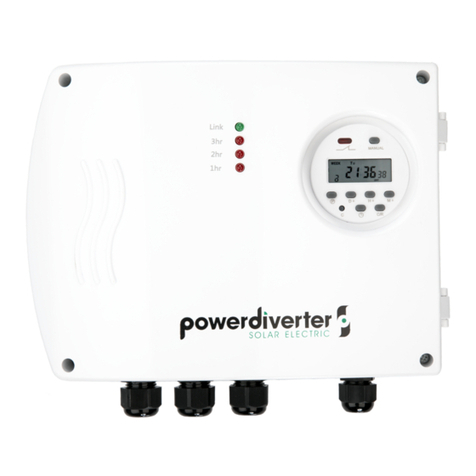6
How to install the Powerdiverter:
To start off you will need to run through a quick checklist to ensure your home is suitable for the
installation. Please check the following:
• Do you have a grid connected solar PV system of at least 1.5kW output power?
• Is the solar inverter output connected to the same phase as the normal supply at the switch
box?
• Do you have a hot water tank with a working water heater fitted to it?
• Is your water heater rated at or below 4800W and 240V AC
• Does the water heater have a working thermostat?
• Is the water heater connected to an existing switched spur circuit? No other appliances
should be connected to it.
If the answer is yes to the all the above then you are ready to go!
Identifying Your Type of Electrical Installation
A variety of installation types exist. Please take a moment to look at the house wiring and select
the closest matching installation type. If in doubt, please contact Powerdiverter support for more
information.
There are two basic types of electrical installation:
Single Phase Supply
This is where the house has a single Active line supply of power that everything is connected
to. The solar inverter, house loads and the water heater all are fed from one Active line into the
property.
This is the easiest type of installation for the Powerdiverter to work with as the Powerdiverter
measures the net import/export power on the Active line where it leaves the property and controls
the water heater in the house fed from the same Active line. The other house loads can all share the
solar power as well.
The remainder of the installation instructions cover this type of installation.
Multi-Phase Supply
This is where the house has two or three Active line supplies.
One will be used for house loads (sockets and lights). The others will be used possibly for the water
heater, the solar inverter and/or other heavy loads (such as air conditioning or a pool heater). There
can be many variations on what is connected where in these types of installations, far too many to
cover in this guide.
The important thing to note is that the Powerdiverter Controller unit controls the active line to the
water heater and this must be on the same Active line phase as the solar inverter. The sensor
clamp (whether used directly with the Powerdiverter Controller or the wireless Sensor Unit) must
measure the net sum power of the solar generation trying to be exported to the grid, less the load
of the water heater trying to be imported from the grid ON THE SAME PHASE.




























